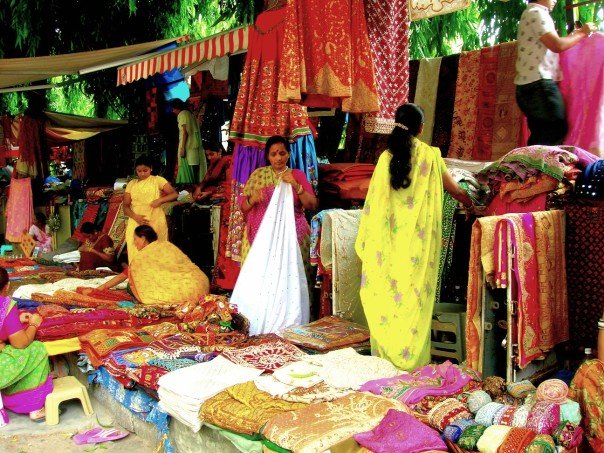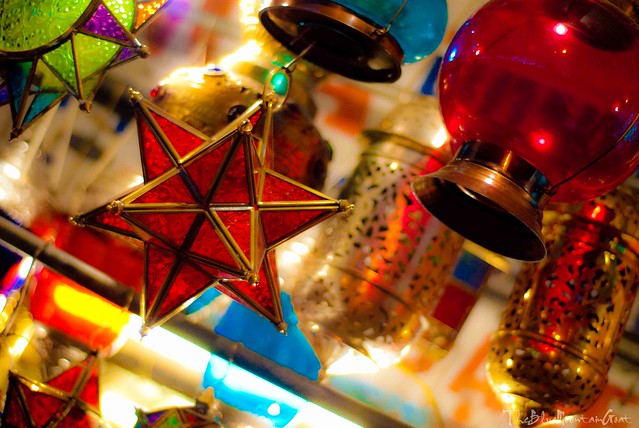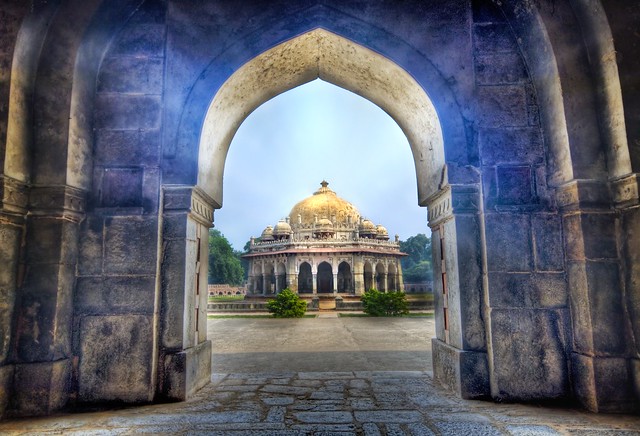Earliest Travel Memories: Conquering New Delhi at Age Eight
From Chennai, we all transported ourselves to Delhi, my mother’s hometown. Delhi! With its claustrophobic noisy market streets, wandering masses, and dogs and rickshaws and cows. Drivers paid no attention to anything in front or back or left or right; traveling felt as haphazard and nonchalant as a game of Nintendo, weaving through obstacles of cattle and pedestrians and cyclists that peppered every major street.

I was eight. My plan was to conquer New Delhi. The buildings were neutral colors, but they were swathed in so many signs that every street looked like a rainbow quilt of storefronts and advertisements. The sidewalks and paths between each building were narrow and secretive.
Venturing into an unknown alley required a great deal of courage; the tight space was like a real world fortune cookie: a surprise, a predestiny come to fruition. It could be pleasant (a mysterious jewelry seller with intricate and bright baubles) or terribly frightening (sinister, leering men in dirty rags). We let our cousins, familiar with the labyrinthine markets, lead us.
I remember sitting on the floor of my family’s old house. The windows were always wide open, allowing the breeze to enter and break the stifling heat. The echoes of the crowded bazaars were audible at all hours of day and night. Every morning, i would wake up and spend the morning watching Indian MTV while eating toasted bread and fruit jam.

(source)
One morning, my cousins took me to Janpath street, a shabby boulevard with acres of street vendors. The air was soaked with the heady scent of henna and freshly made sweets. I stopped at one stall and ran my fingers of the soft silk of a rich blue sari patterned in gold. Swirling patterns of peacocks and hypnotic spirals. I was fascinated by the exquisite embroidery that someone’s patient fingers had sewn so artfully.
“1200 rupees,” the vendor called from her seat.
“Oh no,” I stammered. “I’m only looking.”
“You’re American?” she asked me in English.
“Yes, I am American,” I said shyly.
“My son, he studies in America. He studies in California. Maybe you know him. We make saris to pay for his college. His name is Rajesh.” She rushed this information at me in quick spurts and fragments.
“No.” I said hastily. “I’ve never been to California.”
“He is tall!” she exclaimed, her last-ditch effort at eliciting some recognition of her distant son. “Lots of hair! Have you seen him?”
I tried to explain to her that America was a huge country, spanning thousands of miles, and it was impossible for a nine-year-old to know everyone who lived there. But she continued to insist, detailing everything from his specific skin pigmentation to his astrological sign. I repeatedly and ruefully admitted that I had never seen her son. When she finally believed me, her face dissolved from hope to despair, and to appease her, I forked over the money for the blue and gold sari without haggling or bargaining with her. I was too young then to wear saris, but I imagined Rajesh receiving his money in the mail and the pleased look on his face.
As with any childhood memories, it’s odd what I remember about that trip. Some spots are vivid while the places in between are very blurry, and political or social nuance had yet to color their lasting impressions.
 (source)
(source)
I remember that the next day we went to an ancient temple. I removed my shoes off at the entrance, cringing as I stepped onto a marble floor that was glazed with generations of dirt. I wandered around alone, looking at flower arrangements and paintings and richly jeweled sculptures. I stood between some statues and listened to a priest chanting in an enthusiastic monotone. He waved spoons over little jugs of water and milk, offering them to the idol in front of him. He picked up a plate with a tiny lamp on it and circled it round and round and bells began ringing and everyone clasped their hands in front of their face and bowed their heads. He walked around with the plate, and they cupped their hands around the flame and brought its smoke to their faces.
I was only eight, with a red dupatta on my neck, standing away from the crowd, telling my thoughts to the shivlinga. I always liked telling him secrets. It seemed to me that he understood the fragments of thoughts that always wandered around my brain; perhaps it was because he didn’t have a face, just an enormous forehead with three lines drawn across it. I walked around him three times and stroked the top of his head, because it looked cold. The woman behind me tutted and shook her head at me. Chagrined, I moved my hand away.
Sometimes I dream about being back there, and this is what I remember. In Delhi, in the evening, the sun sets in tints of orange and red, as if someone is smearing mehndi over the skyline. Before bedtime, I used to sit out on the porch with a hot cup of chai. Dust after dusk in Delhi, the world ceases to have a shape and only exists as lights that bob around in every direction. It is a different earth, almost imaginary and almost a dream, but it is real… as real as a scene can be when it is re-colonized by dreams that only I can see.
That was then. But for me, here in the present, it still looks that way. It is a little sad, wistful, full of nostalgia and tender evocation.

(source)
I can try to describe it, how warm and symphonic it is. The sky will change blue to red, and the windows will stay open so that the sweetest part of the summer will float in and leave the city stench behind, and the city will have a pulse – a rhythm that beats evenly with the roar of a civilization which moves onward and onward through all the paths of life with her throbbing heart as a propulsion. This city has a life that tickles everyone, and it moves. The whole structure moves and sways and lurches forward at her insistence.



Follow us on Twitter to get the latest on the world's hidden wonders.
Like us on Facebook to get the latest on the world's hidden wonders.
Follow us on Twitter Like us on Facebook